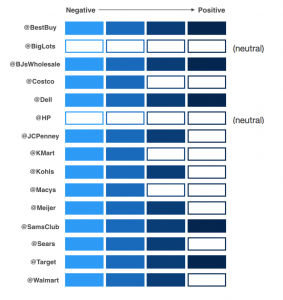BLOG
Christmas Marketing for eCommerce Success: 5 Tips to Increase Gift Sales
Published: Oct 1, 2018

When it comes to retail e-commerce, the success of your holiday marketing can mean make-or-break for your whole year. At Christmas, your shoppers are arriving to buy not for themselves, but for someone else – a very different purchase and consideration journey to what much of what e-commerce marketing is geared up for.
To help you navigate the Christmas marketing challenge, here are our top 4 considerations to help you sell more gifts this season.
1. Know your approach to Black Friday and Cyber Week
50% of Christmas shopping is already complete by December 3rd (yep, we don’t know who these people are either). This shouldn’t come as much of a surprise to anyone who’s been watching Black Friday eCommerce trends over the last few years – the last Friday of November is the highest peak of e-commerce traffic for the whole of Q4.
With half of Christmas shopping completed once these deliveries have hit the doorstep, the implication is pretty clear: Black Friday and Cyber Week is a peak spot for gift shopping, and if your Black Friday marketing campaigns don’t have the gift shopper in mind, you’re missing a trick.
2. Personalize your product recommendations
According to a report from DemandWare, individualized product recommendations led to 30% of Cyber week sales in 2017, despite only having driven 5% of clicks. Across the holiday shopping season as a whole, clicks on product recommendations led to 28% of all retail income.
Product recommendations will be a key part of conversion rate optimisation strategies this season, predicted to drive 25% more sales. This translates to 35% of revenue coming from these personalized purchase suggestions.
But there’s a catch when it comes to gifting: it’s when your shopper might make a sharp turn away from what their shopping habits have looked like at any other point in the year. Personally, it’s the only time I might venture onto the kid’s books’ section of a website – everything you might have already known about my usual shopping habits of overpriced hair products and constantly having to replace lost earphones has gone straight out of the window.
If you can’t rely on your data the way that you usually might, there’s one place you can reliably turn: in-session activity. A great way to increase your e-commerce conversion rate while your user is Christmas shopping is to focus on the here and now – what ad did they land from? What categories have they been browsing? What products have they added to cart? Some simple rule-based activity triggered by behaviors will help keep the customer journey clean and linear.
3. Focus on what your customers really need
For retailers, Black Friday deals are far from a groundbreaking strategy, but consumer behavior from the past holiday season shows that price slashing and couponing is no longer enough.
In 2017, Macy’s lost out on an opportunity to tie its loyalty program with its couponing, which didn’t target any customer segment in particular. J.C. Penney stuck with its usual strategy of inundating consumers with coupons, but it wasn’t enough.
Best Buy stepped up where the department stores fell short. Instead of rushing consumers into buying with “limited time” or “one day only” sales, this retailer offered benefits like free shipping and buyer financing. Incorporating social media into these messages, Best Buy managed to reach the top of the list of brands tagged alongside the #BlackFriday Twitter hashtag:

The lesson for your Black Friday marketing and Christmas marketing is that the online customer journey is now far more complex and nuanced than ever before – having a holiday eCommerce strategy driven by price alone isn’t going to cut it with gift shoppers. While traffic is high, it’s actually a great opportunity to test out new ways of creating perceived value for your customers.
4. Last-minute shoppers are an open goal
Christmas in e-commerce is a longer season than ever before, starting in early November and extending past December 25. In 2017, the first three weeks of November saw significant sales growth, the Sunday before Black Friday being particularly profitable in the mobile space.
While we’ve seen plenty of keen shoppers wrap up (excuse the pun) their Christmas shopping at the start of December, there are still the legions of us who panic two weeks before Christmas. In fact, around 53% of people plan to shop on the last Saturday before Christmas (and among last-minute shoppers as a whole, 51% were planning to shop online). Herein lies a significant opportunity for some last-minute holiday marketing ideas.
The key to successful conversion rate optimization for these last-minute shoppers is offering attractive shipping deals. What we see in the weeks before Christmas is a ‘conversion cliff‘, where traffic stays high but conversion rates drop dramatically – the conclusion is that this is because of last-minute shoppers looking for inspiration but worrying that they’ve missed the delivery window. Make it abundantly clear that they’ve still got plenty of options and you could see this change dramatically.
There’s an additional opportunity in the rarest breed of Christmas gift-shopper: the ones who don’t buy gifts until AFTER Christmas. By late December of 2017, 5% of shoppers were anticipating having to purchase their last Christmas gifts after the holiday. Post-holiday data upheld this prediction with a spike in purchases seen on Boxing Day, December 26. For mobile users, Boxing Day translated to even more sales than the Sunday before Christmas. New Year’s Day is becoming more profitable as well, having increased 32% in 2017.
There’s plenty of holiday marketing opportunity in last-minute gift shoppers – just tune into their particular concerns and differentiate your message to them accordingly.
5. Be mobile-friendly
Mobile is starting to dominate the holiday shopping market in a big way. The 2017 holiday season saw more shopper traffic on mobile devices than on desktops throughout peak days, including Christmas Eve, Christmas Day, and Thanksgiving Day.
Experts are predicting that 2018 will be an even bigger year for mobile: this year, 68% of shopping and 46% of ordering could take place on mobile devices.
The particular challenge for gift shopping on mobile is that the path to purchase when buying for someone else can be longer and more protracted than when buying for yourself. Your shopper might add several items to cart simply in order to bookmark options, before going to comparison shop elsewhere, before picking back up again. The nuances of this customer journey make it more important than ever to have an easily-navigable mobile journey (particularly if that mobile shopper is also a last-minute one…)
Getting the gift shopper
It’s one thing to know that you need to target gift shoppers, but it’s quite another to do it right. Your holiday marketing strategy depends on adapting your usual understanding of how a purchase journey works to how that differs when your shopper is buying for someone else – they might be more confused, more panicked and more price-conscious.
One of the quickest and easiest primers for your Christmas marketing ideas comes in the form of our new e-book – it takes you from Single’s Day to New Year with simple, actionable tips to make your seasonal marketing a success. Click here to read it for free!